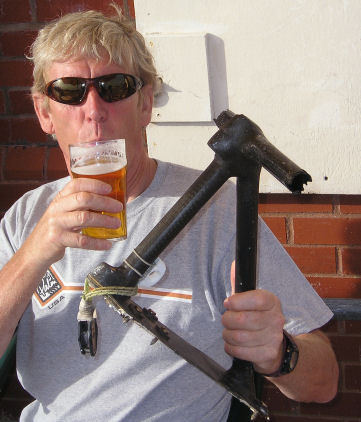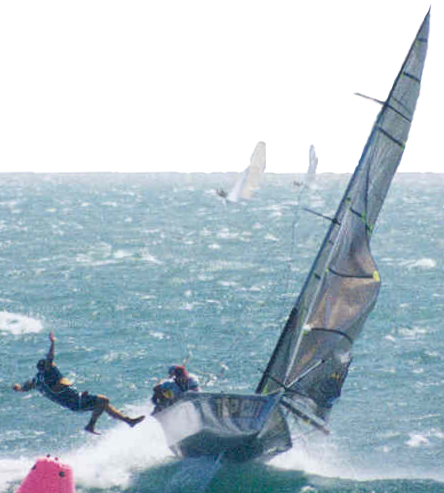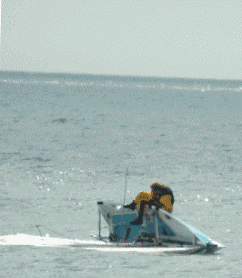A Beginners Guide Skiff Racing.
PREPARATION.
Arrive no more than 30 minutes before the race starts. Preferably with the replacement parts you broke last time, still in their wrappers. Don't bring tools, you can always borrow them off someone. Don't bother with breakfast, order in in passing off the cafe. Make sure that you're at least halfway down the beach, borrowing the insulation tape/string/bailer sponge off some unsuspecting person when your food is ready. Leave the borrowed tools/tape etc in the rescue boat hut with a liberal coating of egg from your rapidly eaten breakfast.
Don't worry about a crew - someone will turn up. If not attempt to subvert the rescue boat crew, time keeper and then members of the public. As a last result phone up any friend with a wetsuit, most of them will appreciate the wake up call, even if they can't sail.
As soon as you have the boat rigged get changed, you should always leave you wetsuit in your locker so you can't forget it. As a result it is wet smelly and unwashed. As well the wetsuit you should have the following. At least 4 gloves, 3 of these should be left hand ones. One wetsuit boot (the other will be at the bottom of one of the black bins) and for the cold days a dry suit - this should have holes in it, borrow some gaffer tape off Barry to fix it. By the time you have found the missing boot you will have missed the briefing. don't worry your crew will have got it. Forget your watch. Borrow Norman's key to get back in for it. Then finish rigging the boat, that means stuffing the tape you borrowed, last weeks empty water bottles, etc. in the halyard pouch. Don't worry about the kicker or cunningham they can be rigged on the way to the start line. While your doing this send your crew back for the dagger board. If your really smart you can give him Norman's key which you forgot to return.
Pull the boat down the beach whilst he is away. And finish changing. Turn the 2nd left hand glove inside out so that it can be worn on the right hand.
LAUNCHING
There are 2 launching techniques, depending on the surf.
1.Small surf. Boat goes in on the trolley. The crew should be at this point in 6ft of water, being dragged under by the trolley. When he/she has taken the trolley up the beach "a bit further", get them to hold the boat, while you run up the beach and sign on. Your wet gloves should make the time sheet soaked. His royal highness, the helm should get only his ankles wet stepping aboard. Helm attaches the rudder, to do this the crew will have hold the boat in deeper water. Just far enough out to loose all grip on the bottom. When ready, crew pushes the nose around, jumps straight over the high side of the heeling boat from shoulder deep water, pops the board in and sheets in the jib and goes out on the wire in one one fluid movement. This is archived by the instructions issued by the helm. "S*@t we're late lets go, in you get f*&@... Jib.... in. IN.. IIIN. Wire s@ $t...Board. Wire." All crews can of course get the dagger board in from the trapeze.
2. Rough weather. Borrow as many people to help as possible. They will all be cat sailors who aren't in hurry because they start latter than the mono's. Get four people to help one at each corner. Helm takes the windward aft corner. The crew the windward front corner. 2 of the 3 cat sailors go to leeward Cleat the jib and carry the boat to the water. the The Wind increases the boats weight 3 fold which ends ups distributed something like 150% front leeward, 100% aft leeward, 45% front windward and 5% aft windward. So the helm can let go to put the rudder on with out trouble. The boat stands like this till a really big wave comes, then the 3rd cat sailor comes to the aid of his fellows. Helm steps on at this point shouts "Lets go" sheets the main in, clothes lines the third cat sailor with the main sheet. And releases the boat from the leeward cat sailors by hitting their heads with the boom. Crew Leaps in from the deep water. Pops in the dagger board. Boat heels crazily and stops as it is now nailed to the bottom by the board. Next wave it takes off side ways narrowly missing a hobie.
STARTING
In Brighton we always have a line at right angles to the beach. Coupled with the swimming area and West Pier then a skiff sailor should start by the pin.The normal method is to sail straight from the beach to the pin, down the line on starboard, helm wiring while crew finishes rigging cunningham, kicker,. re-runs the kite halyard the right way etc. Either charge along the line on Starboard cutting up everyone or pick an unsuspecting victim, sail underneath his slower boat then round up on them shouting up... up... UP. Then bear off and start. The other method relies on actually leaving the beach before the first gun so as to arrive at the line early and sail ballisticly down the line, with no rights causing absolute mayhem. This is method is preferred. When this method is challenged (and it will be) the skiff sailor should say a cat got in his way forcing him to bear off. All monohulls hate cats.
THE BEAT
By now the skiff should be to in bad air, bellow a bunch of lasers, heading either straight for the pier or the the swimming area. Pull ahead of the slower boats and tack. The boat should stop head to wind and fill with water. Forcing a hoard of swearing lasers to avoid your now stationary boat (learnt this one off the hobie cats). Now the boat is really going the crew should come out on the wire to (at least 5 minutes after the start). The correct posture is legs apart as far away form the helm as possible to avoid the smell. As soon as he is on the wire, the helm should explain to him how to set all the rig controls such as lowers, caps, jib cunningham kicker that there was no time to adjust before the start. The crew will instantly understand the finer points of rig tuning and do it all off the wire, or failing that mid tack.
TACKING
Helm Says "Can we Tack yet?" Then when the crew looks over their shoulder to see, the helm pushes the tiller away. Steps into the boat and is trapped by the boom because he's not unhooked quick enough. Crew fails to un-cleat the jib. twists his feet.into a knot with all the string on the floor of the boat. Hooks his cat style harness on the trapeze elastic. Finally gets the jib around mid tack, on the now stationary boat and immediately sheets it in bar tight. Jib fills boat heels viciously and accelerates sideways crew falls over, helm drops main sheet in panic and goes out on his handle to save the capsize. Helm says "Good Tack".
BEARING AWAY AT THE TOP MARK
This is impossible, the helm eases the main and moves his weight back to prevent the nose dive and pulls the tiller. This action causes the crew to fall forward, pulling on the jib sheet to keep balance, completely counteracting the helms weight and main work loading up the tiller and nose diving the skiff.
KITE WORK
Dead simple, bear off. Helm keeps the boat flat by sitting on his backside holding the tiller if the boat heels to windward the transom ballast shouts "Get down", if it Heels to leeward he shouts "weight up" as soon as the crew moves, standing on the tail end of the kite or on the pole the helm corrects the heel with with the rudder. Constant cries of "s&%$ weight back.Pink one, pink, PINK, no not that pink, f@~# weight back, your standing on it. The other one" helps the process. By this time the helm will have got impatient, clipped on and be in his toe loop, crew will be attached to 25 square meters of spinnaker with face pressed firmly against the mast. crew will have approximately 3 seconds to learn to trapeze properly as the "Giraffe having a drink technique" Doesn't work downwind. To help this the crew toe loops have been fitted, the crew's loop should be flattened and twisted into the boat they can't get their foot in, especially if they've foolishly left their trapeze adjuster set for upwind, as back at the toe loop they will trapezing nearly vertical. Crew should look down at the toe loop, over sheet the kite and kick the helm's shins just as a gust hits. When all are eventually settled it will be time to gybe, or on a typical Brighton course a gust will hit and the skiff will have to bear off heading completely the wrong way at speeds in excess of Mach2.
Kite Drops - Don't worry, either the crew will drop it in the water, trawling for mackerel and capsizing the boat or the helm will steer too deep and death roll to destruction and capsize the boat.
This article was heavily based on "A beginners guide to sailing R Class"
 Arrive no more than 30 minutes before the race starts. Preferably with the replacement parts you broke last time, still in their wrappers. Don't bring tools, you can always borrow them off someone. Don't bother with breakfast, order in in passing off the cafe. Make sure that you're at least halfway down the beach, borrowing the insulation tape/string/bailer sponge off some unsuspecting person when your food is ready. Leave the borrowed tools/tape etc in the rescue boat hut with a liberal coating of egg from your rapidly eaten breakfast.
Arrive no more than 30 minutes before the race starts. Preferably with the replacement parts you broke last time, still in their wrappers. Don't bring tools, you can always borrow them off someone. Don't bother with breakfast, order in in passing off the cafe. Make sure that you're at least halfway down the beach, borrowing the insulation tape/string/bailer sponge off some unsuspecting person when your food is ready. Leave the borrowed tools/tape etc in the rescue boat hut with a liberal coating of egg from your rapidly eaten breakfast. STARTING
STARTING KITE WORK
KITE WORK